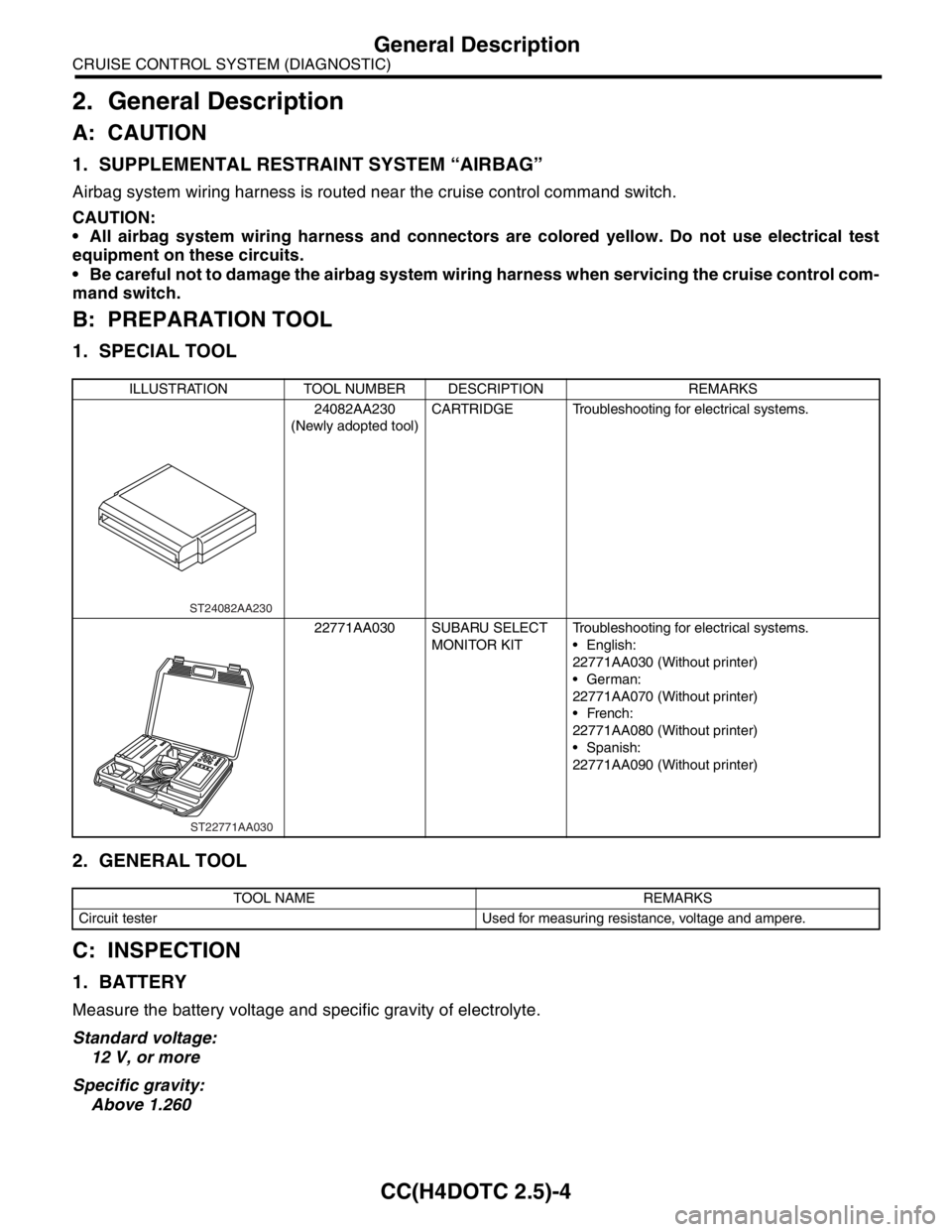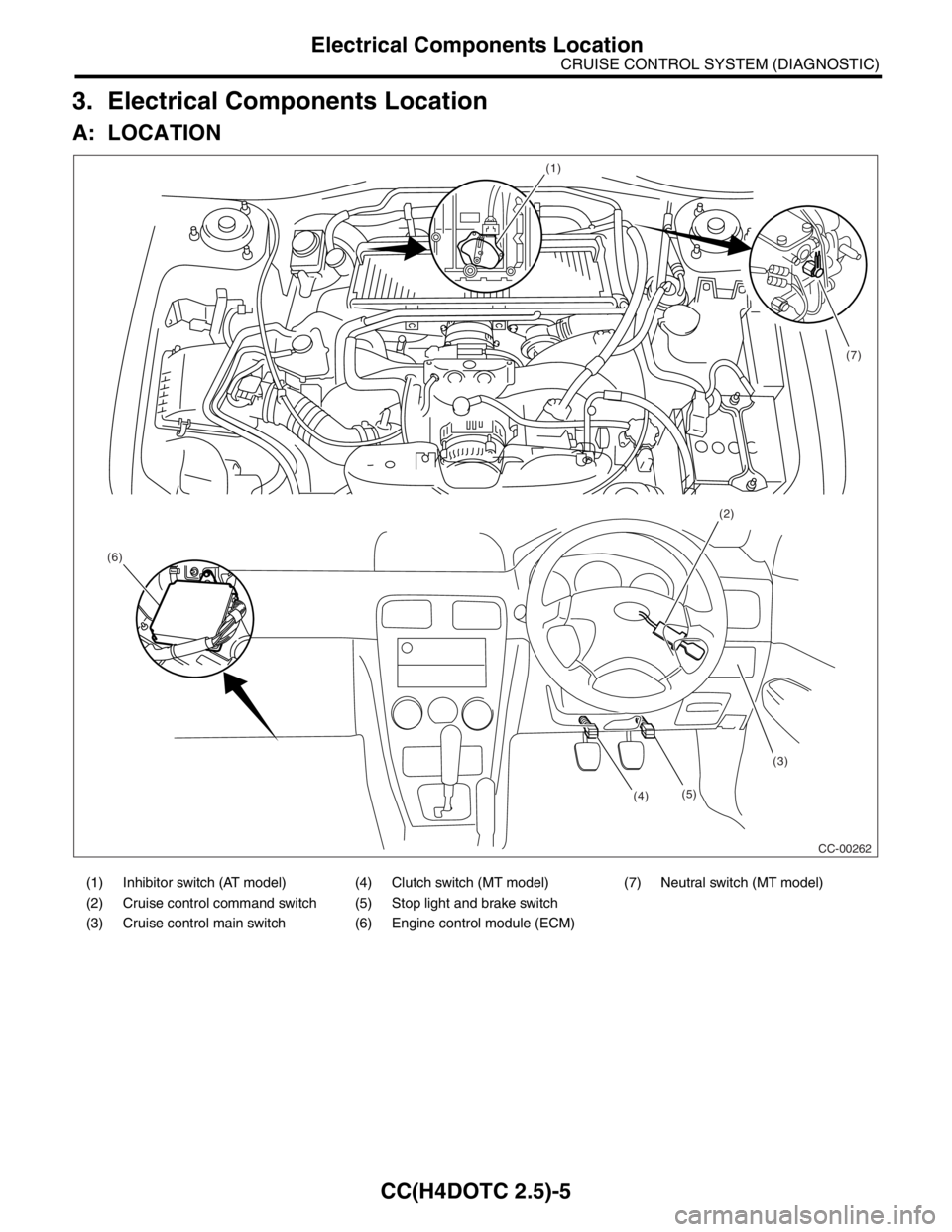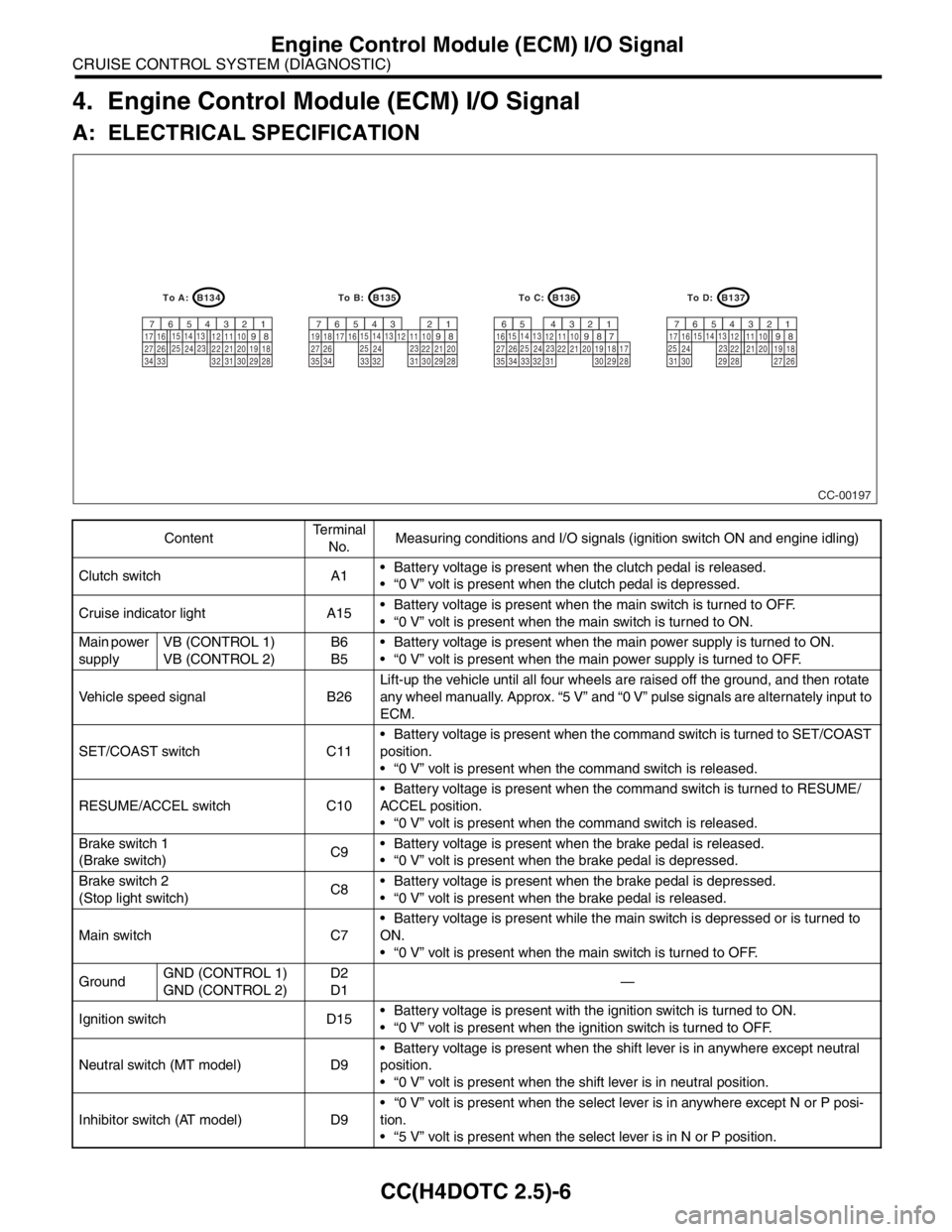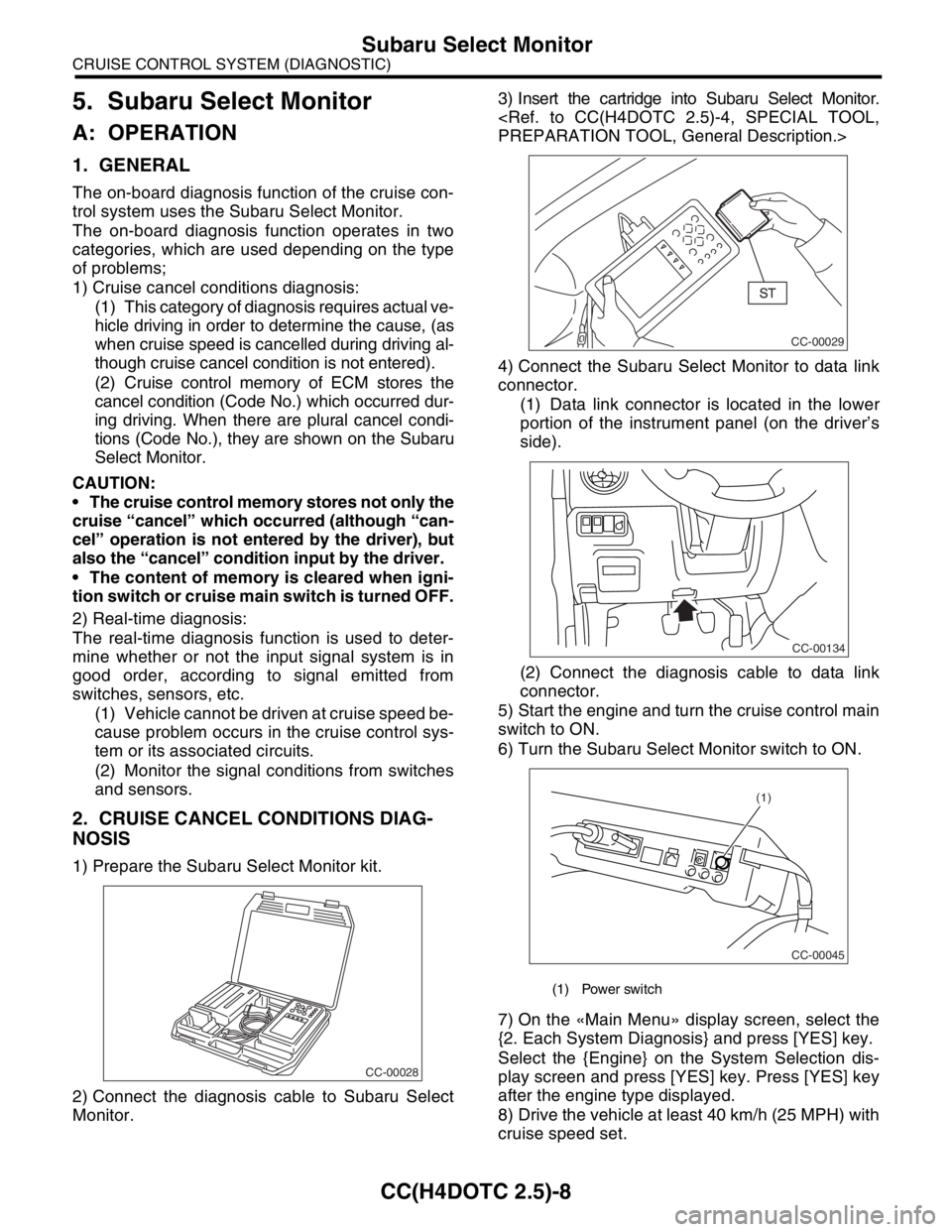2004 SUBARU FORESTER cruise
[x] Cancel search: cruisePage 615 of 2870

CC(H4DOTC 2.5)-3
CRUISE CONTROL SYSTEM (DIAGNOSTIC)
Basic Diagnostic Procedure
10 CHECK CRUISE CONTROL RELEASE OP-
ERATION.
Check the cruise control release operation.Is the cruise control released
after brake pedal has been
depressed?Go to step 11.Go to symptom 7.
10, SYMPTOM
CHART, Diagnos-
tic Procedure with
Symptom.>
11 CHECK CRUISE CONTROL RELEASE OP-
ERATION.
Check the cruise control release operation.Is the cruise control released
after clutch pedal has been
depressed?Go to step 12.Go to symptom 8.
10, SYMPTOM
CHART, Diagnos-
tic Procedure with
Symptom.>
12 CHECK CRUISE CONTROL RELEASE OP-
ERATION.
Check the cruise control release operation.Is the cruise control released
after shifting to neutral posi-
tion?Finish the diagno-
sis.Go to symptom 9.
10, SYMPTOM
CHART, Diagnos-
tic Procedure with
Symptom.> Step Check Yes No
Page 616 of 2870

CC(H4DOTC 2.5)-4
CRUISE CONTROL SYSTEM (DIAGNOSTIC)
General Description
2. General Description
A: CAUTION
1. SUPPLEMENTAL RESTRAINT SYSTEM “AIRBAG”
Airbag system wiring harness is routed near the cruise control command switch.
CAUTION:
All airbag system wiring harness and connectors are colored yellow. Do not use electrical test
equipment on these circuits.
Be careful not to damage the airbag system wiring harness when servicing the cruise control com-
mand switch.
B: PREPARATION TOOL
1. SPECIAL TOOL
2. GENERAL TOOL
C: INSPECTION
1. BATTERY
Measure the battery voltage and specific gravity of electrolyte.
Standard voltage:
12 V, or more
Specific gravity:
Above 1.260
ILLUSTRATION TOOL NUMBER DESCRIPTION REMARKS
24082AA230
(Newly adopted tool)CARTRIDGE Troubleshooting for electrical systems.
22771AA030 SUBARU SELECT
MONITOR KITTroubleshooting for electrical systems.
English:
22771AA030 (Without printer)
German:
22771AA070 (Without printer)
French:
22771AA080 (Without printer)
Spanish:
22771AA090 (Without printer)
TOOL NAME REMARKS
Circuit tester Used for measuring resistance, voltage and ampere.
ST24082AA230
ST22771AA030
Page 617 of 2870

CC(H4DOTC 2.5)-5
CRUISE CONTROL SYSTEM (DIAGNOSTIC)
Electrical Components Location
3. Electrical Components Location
A: LOCATION
(1) Inhibitor switch (AT model) (4) Clutch switch (MT model) (7) Neutral switch (MT model)
(2) Cruise control command switch (5) Stop light and brake switch
(3) Cruise control main switch (6) Engine control module (ECM)
(1)
(2)
(3)
(4) (6)(7)
CC-00262 (5)
Page 618 of 2870

CC(H4DOTC 2.5)-6
CRUISE CONTROL SYSTEM (DIAGNOSTIC)
Engine Control Module (ECM) I/O Signal
4. Engine Control Module (ECM) I/O Signal
A: ELECTRICAL SPECIFICATION
ContentTe r m i n a l
No.Measuring conditions and I/O signals (ignition switch ON and engine idling)
Clutch switch A1 Battery voltage is present when the clutch pedal is released.
“0 V” volt is present when the clutch pedal is depressed.
Cruise indicator light A15 Battery voltage is present when the main switch is turned to OFF.
“0 V” volt is present when the main switch is turned to ON.
Main power
supplyVB (CONTROL 1)
VB (CONTROL 2)B6
B5 Battery voltage is present when the main power supply is turned to ON.
“0 V” volt is present when the main power supply is turned to OFF.
Vehicle speed signal B26Lift-up the vehicle until all four wheels are raised off the ground, and then rotate
any wheel manually. Approx. “5 V” and “0 V” pulse signals are alternately input to
ECM.
SET/COAST switch C11 Battery voltage is present when the command switch is turned to SET/COAST
position.
“0 V” volt is present when the command switch is released.
RESUME/ACCEL switch C10 Battery voltage is present when the command switch is turned to RESUME/
ACCEL position.
“0 V” volt is present when the command switch is released.
Brake switch 1
(Brake switch)C9 Battery voltage is present when the brake pedal is released.
“0 V” volt is present when the brake pedal is depressed.
Brake switch 2
(Stop light switch)C8 Battery voltage is present when the brake pedal is depressed.
“0 V” volt is present when the brake pedal is released.
Main switch C7 Battery voltage is present while the main switch is depressed or is turned to
ON.
“0 V” volt is present when the main switch is turned to OFF.
GroundGND (CONTROL 1)
GND (CONTROL 2)D2
D1—
Ignition switch D15 Battery voltage is present with the ignition switch is turned to ON.
“0 V” volt is present when the ignition switch is turned to OFF.
Neutral switch (MT model) D9 Battery voltage is present when the shift lever is in anywhere except neutral
position.
“0 V” volt is present when the shift lever is in neutral position.
Inhibitor switch (AT model) D9 “0 V” volt is present when the select lever is in anywhere except N or P posi-
tion.
“5 V” volt is present when the select lever is in N or P position.
CC-00197
B134
9
30 29 28 32 3120 19 18 22 2110 12 1114
24
34 3327 2617 16123456713
23 15
258
B135
9
30 29 28
323120 22 2110 12 1114
24
35
3327 2617 16123456713
23 15
258
B136
9
30 29 28
32 3120 19 18 22 2110 12 1114
24
34 3327 261612345613
23 15
258
B137
9
29 2820 19 18 22
2110 12
1114
2417 16123456713
23 15
2581819
34
7173530 3127 26
To D: To C: To B: To A:
Page 619 of 2870

CC(H4DOTC 2.5)-7
CRUISE CONTROL SYSTEM (DIAGNOSTIC)
Engine Control Module (ECM) I/O Signal
B: WIRING DIAGRAM
Page 620 of 2870

CC(H4DOTC 2.5)-8
CRUISE CONTROL SYSTEM (DIAGNOSTIC)
Subaru Select Monitor
5. Subaru Select Monitor
A: OPERATION
1. GENERAL
The on-board diagnosis function of the cruise con-
trol system uses the Subaru Select Monitor.
The on-board diagnosis function operates in two
categories, which are used depending on the type
of problems;
1) Cruise cancel conditions diagnosis:
(1) This category of diagnosis requires actual ve-
hicle driving in order to determine the cause, (as
when cruise speed is cancelled during driving al-
though cruise cancel condition is not entered).
(2) Cruise control memory of ECM stores the
cancel condition (Code No.) which occurred dur-
ing driving. When there are plural cancel condi-
tions (Code No.), they are shown on the Subaru
Select Monitor.
CAUTION:
The cruise control memory stores not only the
cruise “cancel” which occurred (although “can-
cel” operation is not entered by the driver), but
also the “cancel” condition input by the driver.
The content of memory is cleared when igni-
tion switch or cruise main switch is turned OFF.
2) Real-time diagnosis:
The real-time diagnosis function is used to deter-
mine whether or not the input signal system is in
good order, according to signal emitted from
switches, sensors, etc.
(1) Vehicle cannot be driven at cruise speed be-
cause problem occurs in the cruise control sys-
tem or its associated circuits.
(2) Monitor the signal conditions from switches
and sensors.
2. CRUISE CANCEL CONDITIONS DIAG-
NOSIS
1) Prepare the Subaru Select Monitor kit.
2) Connect the diagnosis cable to Subaru Select
Monitor.3) Insert the cartridge into Subaru Select Monitor.
4) Connect the Subaru Select Monitor to data link
connector.
(1) Data link connector is located in the lower
portion of the instrument panel (on the driver’s
side).
(2) Connect the diagnosis cable to data link
connector.
5) Start the engine and turn the cruise control main
switch to ON.
6) Turn the Subaru Select Monitor switch to ON.
7) On the «Main Menu» display screen, select the
{2. Each System Diagnosis} and press [YES] key.
Select the {Engine} on the System Selection dis-
play screen and press [YES] key. Press [YES] key
after the engine type displayed.
8) Drive the vehicle at least 40 km/h (25 MPH) with
cruise speed set.
CC-00028
(1) Power switch
CC-00029
CC-00134
CC-00045
(1)
Page 621 of 2870

CC(H4DOTC 2.5)-9
CRUISE CONTROL SYSTEM (DIAGNOSTIC)
Subaru Select Monitor
9) If the cruise speed is canceled itself (without do-
ing any cancel operations), DTC will appear on se-
lect monitor display after {Cancel Code(s) Display}
is selected on the Engine Diagnosis display screen
and [YES] key is pressed.
CAUTION:
DTC will also appear when cruise cancel is ef-
fected by driver. Do not confuse.
Have a co-worker ride in the vehicle to assist
in diagnosis during driving.
NOTE:
DTC will be cleared by turning the ignition switch or
cruise control main switch to OFF.
3. REAL-TIME DIAGNOSIS
1) Connect the select monitor.
2) Turn the ignition switch and cruise control main
switch to ON.
3) Turn the Subaru Select Monitor switch to ON.
4) On the «Main Menu» display screen, select the
{2. Each System Check} and press [YES] key.
5) On the «System Selection» display screen, se-
lect the {Engine} and press [YES] key.
6) Press the [YES] key after the information of en-
gine type displayed.
7) On the «Engine Diagnosis» display screen, se-
lect the {Current Data Display & Save} and press
[YES] key.
8) Make sure that normal indication is displayed
when controls are operated as indicated below:
Depress/release the brake pedal. (Stop light
switch and brake switch turn ON.)
Turn ON the “SET/COAST” switch.
Turn ON the “RESUME/ACCEL” switch.
Turn ON the “CANCEL” switch. (The “SET/
COAST” and “RESUME/ACCEL” switch are turned
ON at same time.)
Depress/release the clutch pedal.
Set the shift lever to except for neutral position.
NOTE:
For detailed operation procedure, refer to the “SUB-
ARU SELECT MONITOR OPERATION MANUAL.”
For details concerning DTCs, refer to the “List of
Diagnostic Trouble Code (DTC).”
Code (DTC).>
Page 622 of 2870

CC(H4DOTC 2.5)-10
CRUISE CONTROL SYSTEM (DIAGNOSTIC)
Diagnostic Procedure with Symptom
6. Diagnostic Procedure with Symptom
A: SYMPTOM CHART
Symptom Repair area Reference
1Cruise control main switch is
not turned to ON. (Cruise
indicator light does not illumi-
nate)(1) Check the cruise indicator
light.
(2) Check the cruise control
command switch.
Procedure with Diagnostic Trouble Code (DTC).>
2 Cruise control cannot be set. (1) Check the cruise control
command switch
Procedure with Diagnostic Trouble Code (DTC).>
(2) Check the stop light switch
and brake switch.
cedure with Diagnostic Trouble Code (DTC).>
(3) Check the clutch switch.
Code (DTC).>
(4) Check the neutral switch.
Trouble Code (DTC).>
(5) Check the vehicle speed
sensor.
Trouble Code (DTC).>
3Vehicle speed is not held
within set speed ±3 km/h (±2
MPH). Check the vehicle speed sen-
sor.
Trouble Code (DTC).>
4Vehicle speed does not
increase or does not return to
set speed after RESUME/
ACCEL switch has been
pressed.Check the RESUME/ACCEL
switch.
Procedure with Diagnostic Trouble Code (DTC).>
5Vehicle speed does not
decrease after SET/COAST
switch has been pressed. Check the SET/COAST
switch.
Procedure with Diagnostic Trouble Code (DTC).>
6Cruise control is not released
after CANCEL switch has
been pressed.Check the CANCEL switch.
Procedure with Diagnostic Trouble Code (DTC).>
7Cruise control is not released
after the brake pedal has
been depressed. Check the stop light switch
and brake switch.
cedure with Diagnostic Trouble Code (DTC).>
8Cruise control is not released
after the clutch pedal has
been depressed.Check the clutch switch.
Code (DTC).>
9Cruise control is not released
after shifting to neutral posi-
tion.Check the neutral switch.
Trouble Code (DTC).>